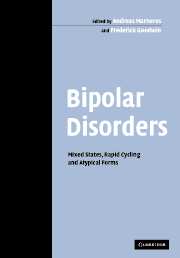Book contents
- Frontmatter
- Contents
- List of contributors
- Preface
- 1 Bipolar disorders beyond major depression and euphoric mania
- 2 Emerging concepts of mixed states: a longitudinal perspective
- 3 Rapid-cycling bipolar disorder
- 4 Bipolar I and bipolar II: a dichotomy?
- 5 Recurrent brief depression as an indicator of severe mood disorders
- 6 Atypical depression and its relation to bipolar spectrum
- 7 Agitated depression: spontaneous and induced
- 8 Schizoaffective mixed states
- 9 Acute and transient psychotic disorder: an atypical bipolar disorder?
- 10 Bipolar disorder in children and adolescents
- 11 Atypical features of bipolarity in old age
- 12 Comorbidity in mixed states and rapid-cycling forms of bipolar disorders
- 13 Challenges in the genetics of bipolar disorder
- 14 Biological aspects of rapid-cycling and mixed states
- 15 The treatment of bipolar mixed states
- 16 The use of atypical antipsychotic agents in the treatment of diagnostic subgroups of bipolar disorder: mixed and pure states, psychotic and non-psychotic
- 17 Investigational strategies: treatment of rapid cycling, mixed episodes, and atypical bipolar mood disorder
- Index
- References
1 - Bipolar disorders beyond major depression and euphoric mania
Published online by Cambridge University Press: 10 August 2009
- Frontmatter
- Contents
- List of contributors
- Preface
- 1 Bipolar disorders beyond major depression and euphoric mania
- 2 Emerging concepts of mixed states: a longitudinal perspective
- 3 Rapid-cycling bipolar disorder
- 4 Bipolar I and bipolar II: a dichotomy?
- 5 Recurrent brief depression as an indicator of severe mood disorders
- 6 Atypical depression and its relation to bipolar spectrum
- 7 Agitated depression: spontaneous and induced
- 8 Schizoaffective mixed states
- 9 Acute and transient psychotic disorder: an atypical bipolar disorder?
- 10 Bipolar disorder in children and adolescents
- 11 Atypical features of bipolarity in old age
- 12 Comorbidity in mixed states and rapid-cycling forms of bipolar disorders
- 13 Challenges in the genetics of bipolar disorder
- 14 Biological aspects of rapid-cycling and mixed states
- 15 The treatment of bipolar mixed states
- 16 The use of atypical antipsychotic agents in the treatment of diagnostic subgroups of bipolar disorder: mixed and pure states, psychotic and non-psychotic
- 17 Investigational strategies: treatment of rapid cycling, mixed episodes, and atypical bipolar mood disorder
- Index
- References
Summary
Introduction: knowledge from the past, goals for the future
The last five decades have brought essential changes and developments in psychiatry. One of the most important reasons for these developments is certainly the psychopharmacological revolution. The discovery of antipsychotics, antidepressants, mood stabilizers, and other psychotropic substances has had an enormous impact, not only on many fields of research, treatment, social life, and social politics, but also on ideological aspects and attitudes. Concerning psychiatric research, the psychopharmacological revolution has been an important and sustained stimulus not only for the development of neuroscience, genetics, and pharmacology, but also for psychiatric methodology, the development of new diagnostic concepts, and new research on treatment, prognosis, and rehabilitation. One indirect but fundamental development was the rediscovery and rebirth of old diagnostic, nosological, and phenomenological concepts. For example, new pharmacological experiences led to the rediscovery of the relevance of the unipolar–bipolar dichotomy. The concepts examined by Falret (1854), Baillarger (1854), Kleist (1929, 1953), Neele (1949), Leonhard (1957), and others were confirmed in the new psychopharmacological era, including the nosological refinements made by Jules Angst (1966), Carlo Perris (1966), Winokur and Clayton (1967), and others. But soon the enthusiasm for the new psychopharmacology gave way to an increasing awareness of some limitations. Within broadly defined diagnostic groups like schizophrenia, depression, and bipolar disorder, many patients proved to be non-responders or partial responders.
Keywords
- Type
- Chapter
- Information
- Bipolar DisordersMixed States, Rapid Cycling and Atypical Forms, pp. 1 - 44Publisher: Cambridge University PressPrint publication year: 2005
References
- 5
- Cited by



